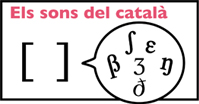Taules de sons - Alguerès
consonants
diacritics
 Description: Description: Indicates an articulation with less voicing than a sound without the diacritic. Usage: Can be used, for example, to indicate the voiceless nature of final rhotics. Position: Under the phonetic symbol. | devoiced |
 Description: Indicates a more retracted articulation than without the diacritic. Usage: Can be used, for example, to indicate the retracted nature of the nasal consonants and pharyngealized alveolar laterals (i.e. postalveolar or prepalatal realizations): esponja [ǝsˈpɔn̠ʒǝ], el joc [ǝɫ̠ˈʒɔk]. Position: Under the phonetic symbol. | retracted |
 Description: Indicates a more advanced articulation than without the diacritic. Usage: Can be used, for example, to indicate the advanced nature of velar sounds when followed by front vowels: quimera [k̟iˈmeɾǝ]. Position: Under the phonetic symbol. | advanced |
 Description: Indicates a dental version of the symbol without the diacritic. Usage: Can be used, for example, to indicate the dental nature of the alveolar nasal consonant or the velarized alveolar lateral (i.e.: antic [ǝn̪ˈtik], el teu [ǝɫ̪ˈtǝw]). Position: Under the phonetic symbol. | dental |
 Description: Indicates an articulation that is lower and more open than a symbol without the diacritic. Usage: Can be used, for example, to represent the middle vowels of the Roussillonese dialect of Catalan (cf. seva [ˈsɛ̞βǝ], seba [ˈsɛ̞βǝ]) or very open varieties of the mid-low vowels such as the variants found in Balearic Catalan and Valencian: mel [ˈmɛ̞ɫ]. Position: Under the phonetic symbols. | lowered |
 Description: Indicates a more raised articulation than a symbol without the diacritic. Usage: Can be used, for example, to represent the more closed variations of mid-low vowels of Catalan varieties like that used in Girona: hora [ˈɔ̝ɾǝ] (northern variety). Position: Under the phonetic symbol. | raised |
 Description: Indicates a more velarized articulation (with raising of the tongue root toward the soft palate) that does not correspond to the same sound without the diacritic. Usage: Can be used, for example, to represent the velarized nature of the alveolar lateral in Catalan: ala [ˈaɫǝ], mal [maɫ]. Position: Under the phonetic symbol. | velarized |
 Description: Indicates a syllabic articulation when under a symbol that represents a non-syllabic sound Usage: Can be used, for example, to represent the syllabic nature of the final liquids in the first person singulars of the present indicative in Balearic Catalan: compr [ˈkompɾ̩], sembl [ˈsɛmpl̩], obr [ˈɔpɾ̩]. Position: Under the phonetic symbol. | syllabic |
 Description: Indicates a non-syllabic articulation when under a symbol that represents a syllabic sound. Usage: Can be used, for example, to represent the non-syllabic nature of the vowels [i] and [u] in decreasing diphthongs, to distinguish semi-vocalic articulations (cf. aire [ˈai̯ɾǝ], caure [ˈkau̯ɾǝ]) from semi-consonants (cf. quatre [ˈkwatrǝ], acció [«kÈsjo]). Also, it can be used to indicate non-syllabic articulations of consecutive vowels found in spontaneous speech (cf. no era fàcil [no e̯.rǝ ˈfa.siɫ]). Position: Under the phonetic symbol. | non-Syllabic |
suprasegmentals
 Description: Before a syllable, indicates that the stress falls on the primary syllable, that is, the most prominent stress of a sequence. Usage: It is assumed that each minor group has a primary stress. Position: To the top left of the phonetic symbol. Alternate system: Acute accent (´) on top of the tonic vowel. | primary stress |
 Description: Before a syllable, indicates where the secondary stress falls, that is, the less prominent stress of a sequence. Usage: It is assumed that each minor group has a primary stress with the option of secondary stresses as well. Position: To the bottom left of the phonetic symbol. Alternate system: Grave accent (`) on top of the tonic vowel. | secondary stress |
 Description: After a phonetic symbol, indicates that the sound has a longer duration. Usage: Used when one wants to indicate elongation, whether spontaneous () or phonological (i.e. to represent a geminated consonant). Position: After the phonetic symbol. Alternate system: Repetition of the affected symbol in question. | lengthening |
 Description: Between two phonic sequences, indicates a minor group border. Usage: Usually corresponds to phonological phrases. Position: Between the phonic sequences. | minor group |
 Description: Between two phonic sequences, indicates a border of the major group or intonation. Usage: May coincide with a pause, but not necessarily. Position: Between the phonic sequences. | major group |
 Description: Between two symbols, indicates that there is a break between syllables. Usage: Utilized to divide a sequence syllabically. Position: Between symbols. | syllable break |





































































